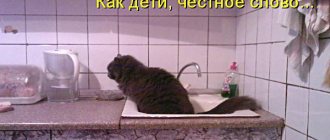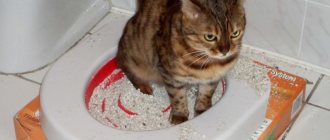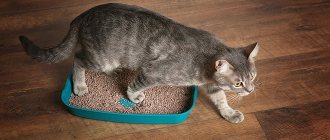Puddles on your favorite carpet, an unpleasant smell in the house - the consequences of the fact that the cat does not want or is not accustomed to go to the litter box. In order for the newly acquired family member to bring only joy, it is necessary, from the first day the kitten appears in the house, to accustom him to a certain place where he should relieve his natural needs. If the owner buys a baby from a nursery, then most likely he already knows how to use a litter tray. He learns this from the example of his parents. But if he is a foundling, came from a shelter or from a private person, then he will have to replace his “mother”.
Choosing a litter box for a kitten
When buying a potty, remember that your pet will grow. Do not take a small box: in a few months you will have to buy a new one. Pay attention to the material. If the box smells unpleasantly of chemicals, the kitten will refuse to empty it.
There are two types of trays - open and closed. The first option is easier to clean, change the filler, and the design takes up little space. An open box is suitable if you plan to do without filler. The only negative is the smell, which can permeate things or cause irritation.
A closed tray is made in the form of a house. This is an ideal option if you plan to place it in a walk-through area (corridor, kitchen). It prevents the smell from escaping and allows the pet to defecate calmly.
Cons of the house:
- high price;
- takes up more space than an open box;
- harder to clean.
You need to be prepared for the fact that the cat may decide that this is his home and make a den there. Sometimes the pet becomes wary and refuses to go inside. In this case, remove the door - it may confuse the baby.
How to train a kitten to use the litter box: litter
In addition to the potty, you need to buy cat litter. It comes in 2 types:
- Absorbent - made from natural raw materials (wood shavings, corn stalks) or artificial materials. Fillers distribute moisture evenly and do not form lumps. They are safe even for small kittens.
- Clumping is based on clay and minerals. The material absorbs moisture, forming lumps that are easily removed with a scoop. The fillers absorb moisture and odors well and can be replaced in parts.
Fillers with aromas are available for sale. We must remember that cats are very picky about smells, so they may refuse to relieve themselves in the box if they don’t like the smell.
Treats and toys
How to teach a kitten to go to the litter box? Buy a treat for reward. When the baby has had a bowel movement, give him a treat and praise him. You can also use toys to reinforce the positive association after going to the toilet.
Filler
Today there are a large number of different fillers:
- pressed sawdust;
- silica gel;
- cellulose;
- scented sand;
- clay.
Each type has its own advantages and disadvantages. Absorbent fillers should be changed frequently and the container should be washed to eliminate odors. The filler should not generate dust or have a strong smell. The owner may like the smell of lavender, but it will irritate the baby’s delicate sense of smell.
It is worth considering that a person has 5 million receptors responsible for the perception of smell, while a cat has 200 million. Veterinarians advise giving preference to natural substances when choosing litter for a kitten’s litter box, and although silica gel absorbs moisture and odors well, a curious baby may want to taste it.
The delicate pads of a kitten's paws can be sensitive to large crystals and pellets, so for the baby the filler should be not only safe, but also comfortable - soft and without sharp corners. The mineral filler absorbs moisture well and is quite comfortable for the paws, but may contain allergens - bleach and asbestos. In addition, it becomes very dusty when falling asleep.
Clumping litters are also not suitable. When clay comes into contact with urine, it forms lumps that can be easily removed with a mesh spatula. This filler is convenient. Economical, but it sticks to the kitten's paws. It is worth taking into account the pet’s preferences in the level of backfill. Some people prefer to rummage for fun and need a thick layer of filler. Others have enough minimum to get everything done comfortably.
Fillers made from processed grain have long been preferred abroad. They are safe, environmentally friendly, and do not emit strong odors.
In our country, this type is represented only by Natural Miracal products made from processed corn cobs. It is not cheap, but it is a clumping type, reliably holds odors and can be thrown into the toilet.
Determining a place for the cat litter box
You must immediately determine the place where the tray will stand. It should be a quiet, calm corner where there are no other pets.
Before you toilet train your kitten at home, build an enclosure-type structure that he cannot leave. There should be enough space to place a tray inside, close to which the baby can play. When the pet gets used to it and begins to relieve itself in the box, the enclosure can be removed and the container moved to a more suitable area.
When choosing a permanent location for the tray, you must proceed from the following considerations:
- Toilet. On the one hand, it is easier to keep the tray clean; over time, the kitten can be trained to go to the toilet. On the other hand, the door must be constantly open, which means that the smell from the toilet will go into the room, corridor, and kitchen. If you forget and close the toilet, the baby will defecate in another place. Alternatively, at the bottom of the door you can make a hole with a curtain through which the kitten will get inside.
- Corridor. If you place the litter box here, you won't have to worry about whether your pet has been blocked from accessing the box, but the smell may be absorbed into the clothes on the hanger. In addition, cats do not like to defecate in busy places. They love privacy.
- Kitchen. Before you teach your kitten to go to the toilet, remember that you cannot place the potty near the bowl, cats will not appreciate this.
The best option is to find a low-traffic place for the box, to which the kitten will have uninterrupted access throughout the day.
We train the cat to use the toilet
Wait until the kitten is 6 months old; after this age, the animal can safely perform the entire procedure in the toilet without using a tray. Also, make sure that the structure of your toilet is safe for the animal in case it accidentally falls into the water. If he can’t get out of the water easily enough, think about it: maybe you shouldn’t train your cat to use the toilet. Or use a special toilet nozzle sold in the store, more about it below.
- Start by moving the litter box to the toilet.
- As soon as the cat begins to constantly go to the right place, place a book or a stack of newspapers 2-3 cm high under the tray every 1-2 days in the first days, and then up to 5-8 cm per day.
- Thus, by about 10-15 days the tray will be at the height of the toilet. Leave the tray on the closed toilet lid for a couple of days.
- If the cat is used to going to the right place, periodically remove the tray, open the toilet lid and leave a little litter at the bottom (if provided for by the design).
- It will take some time for the cat to get used to the toilet and the absence of a tray. The training may take a week, or maybe 2-3 months. Be patient and don’t scold the cat for things that don’t work out right away. On the contrary, be polite and affectionate with him. He feels good and will be more willing to learn new things.
The corner of the litter box is an ideal place to place your cat's litter box. And for toilet training it is a mandatory and necessary condition.
Attention! Pay attention to special toilet attachments for cats, they are sold in pet stores. This is an easier and faster way to train your cat to use the toilet, and you will also protect him from accidentally falling into the water, since the grate blocks access to water. A person will have to remove the nozzle when going to the toilet, and when leaving the toilet, do not forget to put the nozzle back.
Ways to train a kitten to use a litter box
Before you train your kitten to use a litter tray, show him where the litter box is as soon as he gets into the house. Place your baby in the potty and allow him to sniff and explore. Once your pet is familiar with the litter box, do not move the box to another location to avoid confusion.
Kittens defecate immediately after eating or sleeping. When he wakes up or you feed the baby, immediately take your pet to the box with litter, and pick it up no earlier than he has emptied. When you do this several times, the baby will understand that he can do his business here.
How to train a female kitten to use the litter box? If you notice that your pet is sniffing or crouching in a certain place, pick it up and take it to the box.
Be sure to reward your baby when he empties into the tray. Praise, give him a treat, a toy, play with him.
Use your instincts
Cats and kittens have a natural instinct to perform hygiene routines with materials such as sand, so if you put out a litter box as soon as he gets home, he will instinctively start using it in no time. You don't have to teach him what to do, just make sure he knows where he is and his cat instincts will kick in on their own!
Both cats and kittens prefer to bury their feces. This is another instinct that helps them mark their territory and hide their presence from predators... so it's important that you provide your kitty with the right litter box.
© shutterstock
How to train a kitten to use a litter box: tips
- You shouldn’t immediately let your baby walk around the apartment and think that he will figure out where the toilet is. The tray needs to be shown to him and the area of free access limited.
- If you adopted a pet from a domestic cat, ask its owners what kind of litter they use. Better yet, ask for a small handful to put in a pot at home. This is a reliable tool for training a kitten to use the litter box. The baby will come to the smell and do everything right.
- How to easily train a kitten to use the litter box? Buy several boxes. They can be placed in different rooms in places where the kitten can easily reach them. As potty training progresses, the number of crates can be reduced, eventually down to one.
- Until the baby begins to regularly empty the tray while in the enclosure, do not let him out into a large area.
- Do not punish the kitten if it has gone somewhere else, and especially do not poke its nose into the urine. This will cause stress and anxiety, which can make learning difficult. Unlike dogs, cats are not inclined to associate punishment with an incident, even if they are caught in the act. Therefore, such actions will not wean them from shitting in the wrong place. Before you accustom a boy kitten to the litter box, remember this and do the right thing.
- If your baby stubbornly defecates past the box, collect the moisture with toilet paper and place it in a container. This way he will receive a guideline that will indicate where to urinate. Alternatively, you can use a special spray to train your kitten to use the litter box. Sprinkle it into the pot.
- Carefully clean up the area where your baby has puddled or pooped. Use special products that kill odor for this.
- If the kitten goes to the toilet in the same place all the time, place a tray with litter there. Gradually move it in the desired direction. When you absolutely do not want to put a toilet there, place a bowl of food there. Cats do not like to defecate near the feeder.
ADAPTATION OF A KITTEN IN A NEW HOUSE
A kitten in a new home means both unlimited joy from its stay and a great responsibility!
You brought a kitten into your home, and now it is a member of the family who needs your love and care. Show as much attention as possible, call by name. You can choose a pet name here.
The kitten is in the house, which means that within 2-3 days the kitten will probably be sad and bored, but within 1-2 weeks it will completely settle down.
In some cases, adaptation takes up to 1-2 months:
- age over 6 months;
- presence of other pets;
- noisy environment in the apartment (for example, newborn babies, renovations, etc.);
- and other stressful factors for the kitten.
How to help a kitten during the adaptation period?
Try to pay him more attention, pet him, play. If the baby is completely hiding, give him time to sit and get used to the situation. Under no circumstances should you frighten him or forcibly remove him from the place where he hid.
Below are a few points that are important and need to be remembered when you have a new kitten in the house.
How to litter train an outdoor kitten
More work needs to be done with street kittens, since the cat has not taught them to use a litter box. The scheme of actions is the same as when training a pet, adjusted for the age of training the baby to the tray.
The first hours of being in the house are especially important. The baby must be under constant supervision. Your pet must be taken to the toilet every time he decides to defecate. Take him in your arms, caress him, tell him how good he is.
After emptying, do not forget to give a treat, praise, and express delight. Some kittens are quite stubborn and prone to running away, so it is important to limit their movements.
What not to do
When accustoming your pet to the litter box, you should not use physical force, shout, or throw the animal. This behavior of the owner will only scare the baby, and he will begin to hide in the corners.
You should not punish a small kitten by depriving it of food, water or human contact or locking it in a room, as this will lead to a loss of trust on the part of the animal.
Be sure to read:
How many times a day should a cat pee: the norm for an adult animal and kittens, when deviations are safe
How to accustom a kitten to a litter box without litter
Before accustoming a small kitten to a litter box without litter, the baby must learn to use a potty with granules. Once he has mastered the crate, gradually reduce the amount of litter by placing a cage inside. The mesh must be strong and not bend, otherwise the paws will get wet and the kitten will not go to the litter box. You need to buy with the future in mind. When the baby grows up and gains weight, he should not push through the mesh.
It is important to remember about the cleanliness of the drawer and grille. They must be washed after each use. Otherwise, salt deposits and an unpleasant odor will appear. If you are away from home all day and the screen is high, fill the tray with water. It will absorb the smell and make the box easier to clean. Instead of water, you can add a little baking soda.
Toilet cleaning frequency
At the very beginning of forming a habit, it is worth leaving a little used litter in the tray. It will become a “beacon” for the baby. Once the kitten remembers where its litter box is located, it will have to be cleaned and washed more often.
When using clumping litter, it is enough to remove the lumps with a special spatula and add fresh one. The absorbent filler must be changed completely. The tray is washed with warm water and a mild product without a strong odor. The grate is cleaned with a brush to remove feces and stuck filler particles.
The toilet seat is washed after each visit. The discs are gradually removed, and soon nothing will need to be washed.
What to do if the kitten ignores the litter box
A pet may refuse to go to the litter box if it doesn’t like:
- form;
- container size;
- smell or texture of the litter.
Is it possible to train a kitten to use a litter box where he does not want to eliminate? No. Cats prefer a quiet, secluded place where they feel safe. Loud sounds (noise from a washing machine, refrigerator), too many people can cause anxiety, and the cat will refuse to go into the box. How to toilet train a small kitten? Move the container to another location.
If it is difficult to find a quiet place in the apartment, buy a “house”. But problems can also arise with a closed type tray. The pet may refuse to urinate if it is too tight, or if the door or filler is not liked.
Thus, to achieve the desired result, be prepared to experiment - move the pot to a suitable place, change the filler, etc. Another important point: the container must be cleaned on time.
Cleaning and care
Cats love cleanliness, and if the litter box is dirty, they will stop going there. Therefore, you need to properly care for your cat’s litter box:
- Change the litter daily, removing used granules.
- If the litter underneath the pot gets dirty, change it.
- When changing bedding or litter, thoroughly clean and disinfect the tray using special cat litter care products. Do not use chlorine or other aggressive substances that can harm your pet.
Consider the location of the toilet
Just like people, cats like privacy when doing their little things, so make sure their litter box is in a quiet place and away from walking areas. It may be in a corner or a little hidden somewhere.
Make sure the litter box is always accessible and not behind closed doors or near something noisy, such as a washing machine, that might frighten them.
Also, keep the tray away from your kitten's food and water.
After all, people wouldn't eat in our sinks... and cats don't like it either.
Tips and recommendations from a veterinarian: why the kitten suddenly stopped going to the litter box
When your pet went to the litter box normally and suddenly stopped, check the condition of the box. If the potty is clean, pay attention to your pet's behavior. Perhaps something startled him while he was emptying his crate. Fear is immediately visible; he may resist and refuse to move in the direction of the tray.
Other reasons why a cat may refuse to go into a box:
- Sexual instinct. If this is not a breeding animal, have your pet spayed/neutered. The operation will relieve many problems.
- Protest. For example, the pet does not want to sit at home on its own, or the owner does not pay attention to it.
- Unpleasant associations. Perhaps he was toilet trained using rough methods, punished, and now he is afraid of the litter box. Try buying a box of a different shape and changing the filling. Don't forget to express delight when the kitten defecates in the box.
Among the reasons why puddles and feces began to appear outside the tray are urinary tract infections and worms. To notice the problem in time, talk to your veterinarian and get tested.
Problems in a well-functioning mechanism
It often happens that a little fidget, seemingly already accustomed to one place and its own tray, “forgets” about it and begins to “walk” under the closet or to a secluded corner on the carpet. We definitely need to fight this.
- You should not use the old-fashioned method (poking with your nose and dragging it into the tray). Such actions will certainly form a negative attitude towards the allocated place, which will only aggravate the situation. It will be enough to scold the kitten slightly. Cats are good at distinguishing intonation, so the scoundrel will quickly understand that he did something wrong.
- Excrement should be removed as soon as possible, and it is best to use a special spray or liquid that removes stains and odors, so that in your pet’s memory the new place is not associated with the toilet. The collected “goods” can be sent to the tray, thereby showing, including by smell, where they should be.










